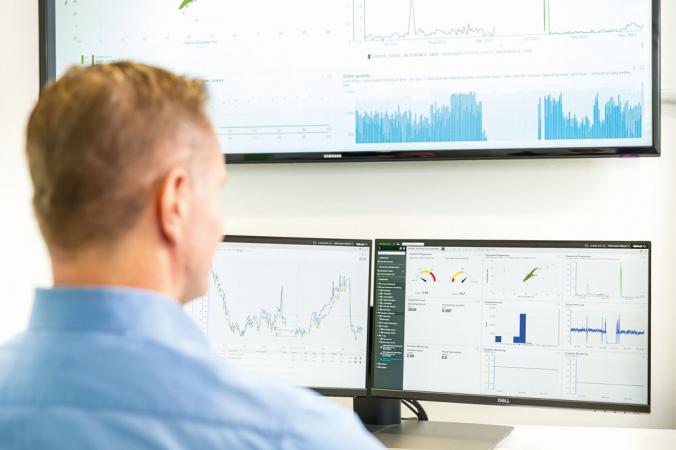Ten Things Vibration analysts Should Do, But Often Don't
Vibration analysts have a tough job to perform – as well as an important one. But there are some changes that vibration analysts can do to make their job easier.
In this article we will look at ten techniques that are often not utilized by vibration analysts but, in fact, should. Six more points will be explained in the following issue of Maintworld -magazine.
One: Use of Phase Analysis
Phase analysis helps the analyst understand the motion of the machine, which is driven by the internal forces. When the machine is out-of-balance it moves differently to when the machine is misaligned.
The same is true when the machine has a bent shaft, eccentric pulley, cocked bearing, cracked or otherwise weak foundations, and a resonance condition. Yet all of these conditions can look similar in the vibration spectrum.
Two: Time Waveform Analysis
Time waveform tells you so much about what is happening: For instance, as the shaft turns and gears mesh together, rolling elements pass over spalls in the raceway or rattle around due to looseness and impeller vanes surge through the liquid causing cavitation.
Yes, it is often possible to accurately diagnose faults with the spectrum alone, but it is amazing what you can see in the waveform that tells you far more about the nature and severity of the fault condition. The only challenge is that you need to measure it correctly and be willing to look at it.
Three: Use a Log Amplitude Scale
Spectrum analysis is very powerful, but it is amazing what you can miss if you only look at it with a linear amplitude scale. When you toggle to log (logarithmic y-scale) various patterns can be revealed including harmonics, sidebands, and “humps” in the noise floor that indicate the presence of resonance.
The log scale also highlights differences between measurements collected on different dates. Just one of the benefits of using the log scale is that you get a much earlier warning of bearing faults and you get a better idea of the residual life of the bearing.
Four: Order Normalize
If you were to look at a poster of common vibration fault patterns, or were using an iVibe app, you would see that many of the fault patterns are either “synchronous”, that is, integer multiples of running speed (such as unbalance, misalignment, looseness, pump flow issues, gear mesh) or they are “nonsynchronous”, meaning that non-integer multiples of running speed – most importantly, rolling element bearing faults.
When you look at a spectrum with the X axis in hertz or CPM it is difficult to tell if a peak is synchronous or nonsynchronous. The best thing to do is simply scale the X axis in “orders”, which is basically dividing all of the frequencies by the running speed thus the peak at the running speed is 1X.
You will be amazed how easy it is to see patterns and how they are related to the running speed.
Five: Understand Averaging
In order to be more efficient we need to spend less time collecting data, but instead make sure that we collect good data. In the old days we were typically recommended to take between 4 and 10 averages. But that was when we were collecting 800 line spectra.
When you move to 1600 lines you double the collection time. For 3200 lines you quadruple the measurement time. Resolution is good, but quadrupling measurement time is bad.
The answer is to take fewer averages. Like all of the issues discussed in this article there is a long technical explanation for why this works, but the simple way of describing it is that we are averaging so we hear the whole story from the machine. If 8 averages at 800 lines is enough to hear the story, 4 averages at 1600 lines or 2 averages at 3200 lines may be enough, also.
Six: Use Two Frequency Ranges
It was just stated that we want to “hear” the whole story from the machine. The machine generates “low frequency” vibration related to unbalance, misalignment, looseness and other common faults. It also generates “high frequency” vibration related to gear mesh, lubrication problems, bearing faults, and other faults.
The trouble is, if you collect one spectrum that includes both the low frequency and high frequency vibration, it can make it very difficult to see the very important detail at the low-frequency end of the spectrum.
The simple solution is to acquire two spectra; one to approximately 10 times the speed of the machine, and a second spectrum to approximately 100 times the speed of the machine. Not only does that make the analysis process much faster and fool proof, if you also collect time waveforms with both spectra you will have very useful time waveform data to analyse.
Seven: Mount the Sensor Correctly
There are two very important factors to consider when collecting vibration data: repeatability and frequency response. Repeatability ensures that changes in the data are not related to the way the measurement was taken.
The frequency response is important because when rolling element bearings begin to fail, and when there are lubrication issues, the vibration generated is very high in frequency. The only way to ensure repeatability and frequency response is to mount the sensor correctly.
If you use a two-pole magnet, you are limiting the frequency response. And when you mount the accelerometer on a dirty surface, or a surface that has multiple layers of paint, or a surface that is not flat, we can affect repeatability and frequency response. The bottom line is that it pays to mount a flat magnet on a mounting pad that has been permanently installed on the machine, or to use a quick-connect adapter.
Eight: Listen to the Vibration
You may be surprised to read this one. This is old school. But the fact is that when we measure vibration the measurement system is only listening to the machine for a very short time. The machine can have a very interesting story to tell, and it is amazing how much we can detect just by listening to the vibration.
There are all kinds of sounds you will hear, and the fact that you are listening for much longer than is captured in a time waveform means that you will detect faults that could be missed otherwise. Try it – you will be surprised what you hear.
Nine: Beware of Standard Alarms
Vibration alarm limits from ISO 10816, and other so-called “proven” fixed alarm recommendations both fail for one very important reason – the same machine doing the same thing but mounted slightly differently can vibrate very differently. Machines resonate. Structures resonate.
Resonance can either drastically increase the amplitude of vibration or reduce that vibration. Therefore you need to set alarms based on the normal operating conditions of your machine. And that leads us to number ten.
Ten: Try Statistical Alarms
There are two common ways to set alarm limits on the vibration you measure from your machine. They are “band alarms” and “mask alarms” (so-called envelope alarms). Both methods are seriously flawed. Neither method tolerates speed variation or small variations in vibration amplitude.
Those variations can indicate that fault conditions exist. Using these methods can lead to false positive and false negative alarms. As a result, the vast majority of vibration analysts do not use alarm limits at all. But that means they have to manually analyse every spectrum and that can be a huge drain on precious resources and can lead to faults being missed altogether.
The solution is to use alarm limits based on statistical calculations. Basically, these calculations look at how every line in every spectrum taken from an individual point varies over time. If it appears to “normally” vary a lot, the alarm limits will accept more variation than at frequencies where variation is not normal. It is as if these techniques “learn” from your machines and thus when the vibration is abnormal it will be reported to you. This is important with normal “route collection” but exceptionally important with online monitoring systems.








![116716-AMS-Machine-Works-digital-banner_300x600_MaintWorld_EN[52] 116716-AMS-Machine-Works-digital-banner_300x600_MaintWorld_EN[52]](/var/ezwebin_site/storage/images/media/images/116716-ams-machine-works-digital-banner_300x600_maintworld_en-52/78645-1-eng-GB/116716-AMS-Machine-Works-digital-banner_300x600_MaintWorld_EN-52.png)



